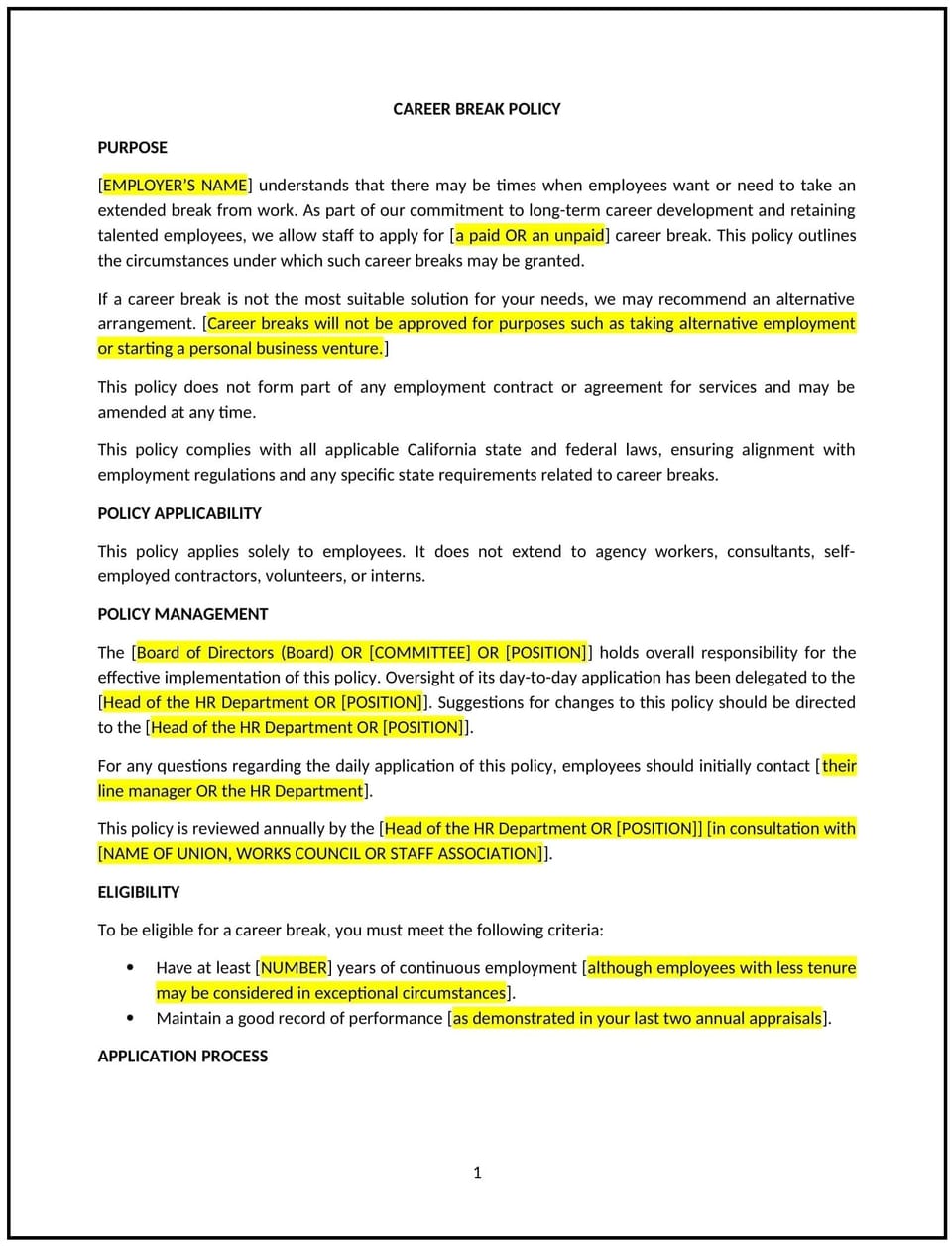Career break policy (California): Free template

Career break policy (California)
In California, a career break policy provides businesses with guidelines for granting employees extended periods of unpaid leave to pursue personal or professional development goals, such as travel, education, or caregiving. This policy ensures that career breaks are managed consistently while supporting operational needs and compliance with California labor laws.
This policy outlines eligibility, application procedures, and terms for returning to work. By implementing this policy, California businesses can foster employee satisfaction and retention while maintaining workplace productivity.
How to use this career break policy (California)
- Define eligibility: Specify which employees are eligible for a career break, such as those with a certain length of service or in specific roles.
- Establish application procedures: Provide clear steps for employees to request a career break, including required documentation and notice periods.
- Set terms of leave: Clarify the duration of career breaks, any restrictions on activities during leave, and whether benefits will continue.
- Outline return-to-work conditions: Detail the process for rejoining the business, including role reassignment or training if necessary.
- Communicate expectations: Ensure employees understand their responsibilities, such as maintaining communication during the career break if required.
Benefits of using this career break policy (California)
This policy offers several advantages for California businesses:
- Enhances retention: Demonstrates the business’s flexibility and support for employees’ personal and professional growth, fostering loyalty.
- Promotes fairness: Establishes consistent guidelines for granting and managing career breaks, reducing potential conflicts.
- Supports compliance: Reflects California labor laws and ensures fair treatment of employees during extended absences.
- Reduces disruptions: Provides a structured process for managing workloads and operational needs during career breaks.
- Encourages planning: Helps employees and the business align expectations, minimizing challenges during and after the leave period.
Tips for using this career break policy (California)
- Reflect California-specific laws: Ensure the policy complies with any state-specific requirements related to unpaid leave or benefits continuation.
- Plan for operational coverage: Develop strategies for managing workloads during employee absences, such as temporary hires or redistributing tasks.
- Communicate openly: Encourage employees to discuss their career break plans early to facilitate smooth transitions.
- Document agreements: Keep clear records of approved career breaks, including terms and conditions, to support consistency and transparency.
- Review regularly: Update the policy to reflect changes in California laws, business needs, or workforce expectations.
Q: How does this policy benefit the business?
A: This policy supports employee retention, promotes fairness, and provides a structured approach to managing career breaks.
Q: Who is eligible for a career break under this policy?
A: Eligibility is typically based on factors such as length of service or role requirements, as outlined in the policy.
Q: How does this policy support compliance with California laws?
A: The policy is designed to reflect California labor laws, supporting fair and lawful management of extended leave.
Q: What steps should employees take to request a career break?
A: Employees should submit a formal request with the required notice and documentation, following the procedures outlined in the policy.
Q: How can the business manage workloads during an employee’s career break?
A: The business can redistribute tasks, provide cross-training, or hire temporary staff to ensure productivity is maintained.
This article contains general legal information and does not contain legal advice. Cobrief is not a law firm or a substitute for an attorney or law firm. The law is complex and changes often. For legal advice, please ask a lawyer.


